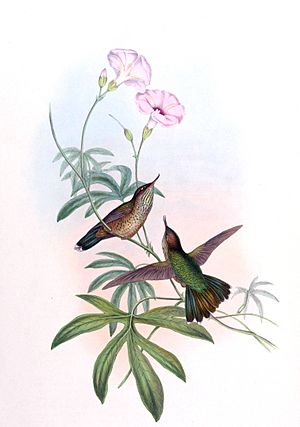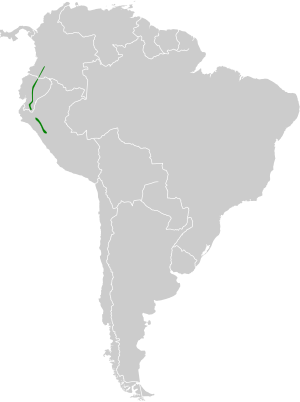Mountain avocetbill facts for kids
Quick facts for kids Mountain avocetbill |
|
|---|---|
 |
|
| Conservation status | |
| Scientific classification | |
| Genus: |
Opisthoprora
|
| Species: |
euryptera
|
 |
|
The mountain avocetbill is a tiny, colorful bird. It's a type of hummingbird found in the mountains of Colombia, Ecuador, and Peru. This special bird is known for its unique bill that curves slightly upwards. Its scientific name is Opisthoprora euryptera.
Contents
A Unique Hummingbird Family
The mountain avocetbill is quite special because it's the only species in its own group, called a genus. Think of it like being the only kid with a certain last name! It doesn't have any different types or "subspecies" within its group. This bird is related to other hummingbirds like the hillstars and trainbearers. Scientists first described it a long time ago, in a very big group of hummingbirds called Trochilus.
What Does It Look Like?
The mountain avocetbill is a small bird, about 10 to 11 centimeters (4 to 4.3 inches) long. It weighs about 5.8 to 6.6 grams (0.2 to 0.23 ounces). Its bill is short and turns up slightly at the very end.
Its upper body is a shiny bronzy green color. It has a clear white spot right behind its eye. The tail is shaped like a "V" (notched). The feathers in the middle of the tail are bronzy green. The outer tail feathers are dark blue with thin white tips.
The throat and chest of the bird are white. Its sides and belly are a reddish-brown color. All these areas have dark green streaks, like little stripes.
Where It Lives
The mountain avocetbill lives in different spots across the Andes mountains. You can find it in central Colombia, on the eastern side of the Andes in Ecuador, and in a few places in northern Peru.
It likes to live inside forests, at the edges of forests, and in open areas within the woods. It especially likes "elfin forests," which are misty, high-altitude forests with small, twisted trees. It also lives in humid mountain forests. Sometimes, you can even spot it in bushes along roadsides.
These birds live at high elevations. In Colombia, they are found between 2,600 and 3,600 meters (8,500 to 11,800 feet) above sea level. In Ecuador, they are mostly between 2,400 and 3,200 meters (7,900 to 10,500 feet), but sometimes as low as 1,700 meters (5,600 feet). In Peru, they live between 2,700 and 3,200 meters (8,900 to 10,500 feet).
Behavior
Movement
The mountain avocetbill doesn't travel far. It stays in the same area throughout its life. This means it is a "sedentary" bird.
Feeding Habits
This hummingbird looks for food up to 3 meters (10 feet) above the ground. It drinks nectar from flowers in two ways. Sometimes it hovers in the air, flapping its wings very fast. Other times, it clings to the flower to drink.
It can also be a "nectar robber." This means it might poke a hole at the base of a flower to get the nectar without helping the flower spread its pollen. We don't know all the flowers it visits, but it has been seen feeding from plants like blueberries (Ericaceae) and fuchsias (Onagraceae). It also eats small insects. It catches these insects by flying out from a perch and snatching them in the air.
Reproduction
Scientists don't know much about how the mountain avocetbill reproduces. We don't have detailed information about its breeding season or how it raises its young. Like most other hummingbirds, it is believed to be "polygynous." This means one male bird might mate with several female birds.
Vocalization
The sounds the mountain avocetbill makes are not very well known. However, it does make a series of thin, whistling sounds that go down in pitch. It sounds a bit like "wsee wsee wsee wsee."
Conservation Status
The IUCN (International Union for Conservation of Nature) has evaluated the mountain avocetbill. They have listed it as a species of "Least Concern." This means it is not currently considered to be in danger of disappearing.
Even though it lives in a small area, its population seems to be stable. Some people think it's rare, while others find it more common in certain parts of its range. Human activities don't seem to have a big effect on the mountain avocetbill in the short term.
See also
 In Spanish: Colibrí picolezna para niños
In Spanish: Colibrí picolezna para niños


